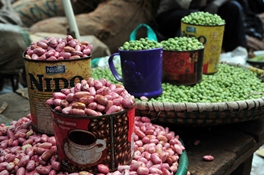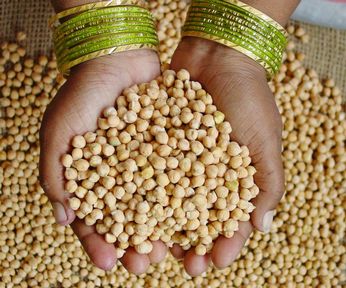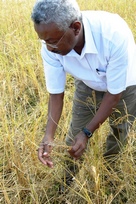Big on beans, blogs, videos and all
- Published Date

We've been big on beans lately, featuring ongoing work in our Legumes Research Initiative, and more specifically, the Tropical Legumes I project (TLI), wihich GCP leads. You can zoom in on our bean research here.
Our latest offering is a blogpost on breedings beans that beat the heat in Zimbabwe, with Godwill Makunde and Kennedy Simango, both from Zimbabwe's Crop Breeding Instititue.
Prior to that, late last year, we sat at the table with CIAT's Steve Beebe, and he walked us through how researchers are sidestepping variety to create new varieties to combat drought, disease and pests. Apparently, beans come in a mindboggling and bewildering broad array. This huge diversity is both a blessing and a curse, calling for careful 'navigation' and circumspection in the treachorous 'straits' in search of treasured traits in bean breeding. CIAT is leading the TLI work on bean breeding.
After that chat with Steve, our next stop was Awassa, Ethiopia, where we caught up with Asrat A Amele. Here, he tells us how the Selian Agricultural Institute (SARI) is breeding beans to better battle drought and disease.
And that's not all we did in Ethiopia: if you're one of those captivated by tales told in the true tradition of story-telling, with magic, fairies, beanstalks and all, then this blogpost is an a must read for you. Our ace field reporter weaves a riveting tale here of magic beans and giant beanstalks, seen through a communicator's eye and skillfully narrated.
To round things off and come full circle, on to video and back to Steve Beebe: we go one-on-one with him In this six-minute clip. Steve briefis us on current efforts to bridge the bean research breach by applying 'battle' tactics such as phenotyping, capacity building and cross-regional collaboration across Africa and Latin America. He describes how these TLI endeavours semalessly flow into the ICRISAT-led Tropical Legumes II project (TLII) which focuses on seed multiplication. In Africa, focus is on Ethiopia, Kenya, Malawi,Tanzania (TLII) and Zimbabwe. Watch the video
More videos to follow, so please watch this space!
InterDrought-IV Conference: A meeting of the minds on mutual matters and money
- Published Date

A great deal on drought and developing countries
GCP is one of the sponsors of the InterDrought–IV conference to be held in September 2013.
But this is not a new deal: GCP has consistently supported InterDrought since the very first conference.
“Since its inception, GCP’s key trait of focus in plant research has been drought, and this is where we find a natural confluence with the InterDrought Conference,” says Jean-Marcel Ribaut, GCP’s Director. “Another common pillar we share is the emphasis and focus on capacity building to empower researchers in developing countries by enabling them access integrated breeding. With this focus, our sponsorship is specifically earmarked to facilitate the participation of these researchers in the InterDrought conferences.”
The funds are being managed by the conference organisers under the auspices of the conference’s bursary programme.
Deadline for bursaries for developing-country scientists is 15 March 2013.
More details on our IBP website.
Previiosly late last year, we announced bursaries for the conference here.
Orphan no more: Chickpeas join exclusive 'closed club' in the crop world
- Published Date

Just as this time last year, the genomics crack-team has done it again!
In an auspicious start to 2013, scientists have successfully completed the draft genome sequence of chickpeas.
This good news is revealed in an open-access article published today in Nature Biotechnology, entitled Draft genome sequence of chickpea (Cicer arietinum) provides a resource for trait improvement.
The study describes the genome sequence of 90 cultivated and wild chickpea genotypes from 10 countries. This is a veritable treasure trove of genomic resources, and paves the path for modern breeding to improve this important food crop – a great boost for chickpea farmers in the developing world.
The work was conducted under the auspices of the International Chickpea Genome Sequencing Consortium (ICGSC), comprising of 49 scientists from 23 institutes spanning Asia, Australia, Europe and North America. This chickpea sequencing project was partially funded by GCP.
- More details: Press release | Blog | Photos on Flickr
- See the good news from this time last year here.
GCP workshop at the Plant and Animal Genome Conference 2013 (PAG XXI)
- Published Date
 As always, at this global event last month, GCP hosted a side event, graced by a panel of eminent scientists and excellent speakers.
As always, at this global event last month, GCP hosted a side event, graced by a panel of eminent scientists and excellent speakers.
This workshop on January 14 2013 highlighted selected key GCP projects, with some of our research partners in attendance. Altogether, there were about 150 participants.
“It was amazing to see the excellent progress on these projects,” says Rajeev Varshney, Leader of GCP's Comparative and Applied Genomics Theme. He adds, “On the one hand, there was the ongoing basic gene discovery work for phosphorus uptake efficiency in maize and sorghum. On the other hand, QTL deployment was demonstrated in chickpeas.”
GCP would like to thank all who attended the event.
More on our genomics work in cereals here
Meet 'The Godfather I': Rice plus a dash of salt-and-P with Abdel Ismail
- Published Date

You already met 'The Godfather II' of the 'rocking R' blopost here, and we'd now like for you to meet the original godfather of not only PSTOL1, but also SALTOL. Don't worry: we'll decipher those two cryptic terms in just a moment...
This week, our blogpost profiles Abdelbagi Ismail (pictured), a Plant Physiologist at the International Rice Research Institute (IRRI). Travel with Abdel on an epic journey of discovery that will take you from his native home in Africa on the bountiful banks of the Nile, and on to Asia's ricelands, with a brief stopover America.
Abdel tells us about the passion of his life – plant science – and his active contribution to it. The focus is his work on two rice genes - Saltol, which confers salt tolerance allowing rice to not only grow thrive in saline soils, and its 'phosphoric' counterpart PSTOL1 (phosphorus starvation tolerance) gene, which does the same for rice in phosphorus-poor soils, by improving the uptake of this valuable nutrient. For this reason, project scientists dubbed the location of the PSTOL1 gene as Pup1, standing for phosphorus (P) uptake.
Soil salinity is a major problem, particularly in Asia's coastal regions, where rice-based farming systems are the norm. Moving further out into the rest of world and going further up into the highlands, globally, more than half of all cropland is low in plant-available phosphorus. This poses a serious problem for poor, remote, rice-farming communities that must manage without fertilisers. Many such communities depend on upland rice. And while upland soils may have phosphorus, the problem is that this critical nutrient is locked in forms that are not readily available to rice plants, especially in acid soils.
But let Abdel tell us the story since he does it so much better than we ever could. Please read on!


